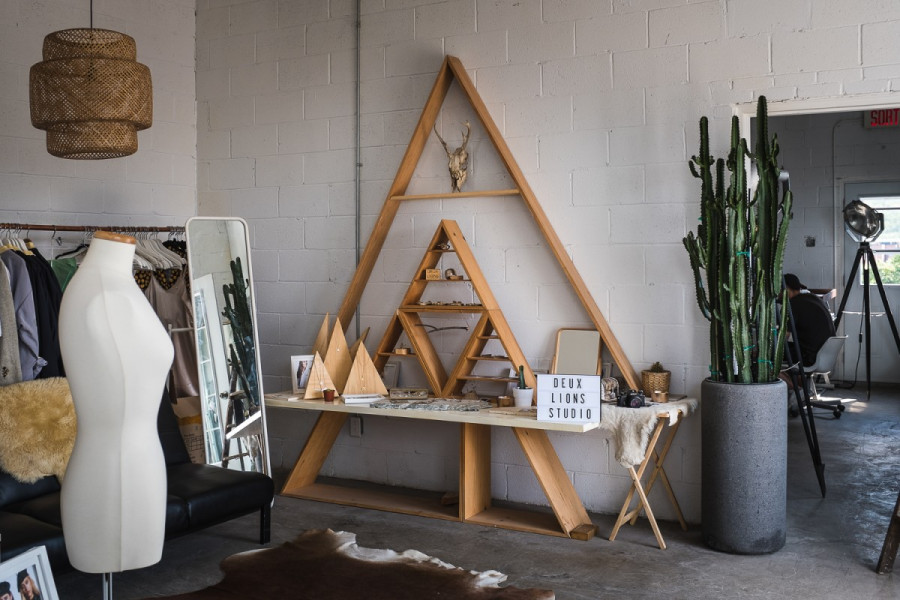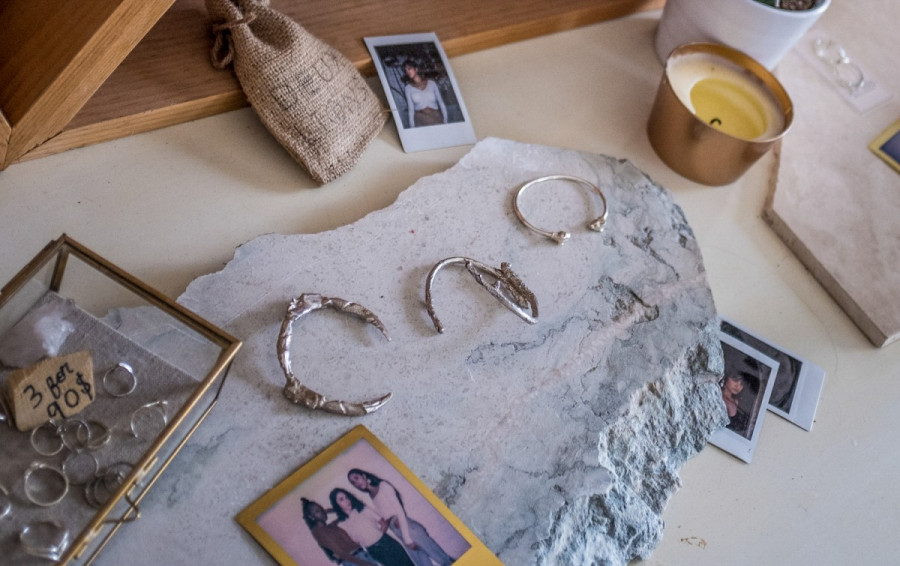Deux Lions Makes Luxury Jewelry Accessible for All
Silversmith Siblings Talk of the Importance of Women in Their Craft
Niched on the fifth floor of a rusty-looking building, Deux Lions’ studio feels welcoming and luxurious.
A narrow corridor leads to the main room—a small showroom, decorated simply and tastefully.
Couches surround the space, tables showcase the jewelry the brand offers: bulky earrings, thin bracelets, dainty chains. Gold, brown, and white dominate, with slight touches of green and pink, on posters and polaroid pictures. Muffled music adds to the laid-back atmosphere.
Charlotte Piché is the founder, creative director, and co-owner of Montreal-based jewelry brand Deux Lions. Though they’ve gone through many changes since opening in 2014, the driving idea behind Deux Lions has remained the same.
“Jewelry is, for me, one of the industries that kind of touches women of all sizes and all ages,” she said. “It gives luxury to women no matter what. We try to do affordable luxury, to be available to people who aren’t necessarily very wealthy but still want to indulge in a nice little piece.”
The space the brand occupies on 4112 St. Dominique St. serves as a place to welcome customers as well as a workshop where Charlotte and her brother and co-owner, Alexandre, design and produce all the pieces they sell.
They bought the studio in October 2017. Before that, Deux Lions grew through pop-up shops, art galleries and various beauty and fashion stores across the city, and later, through its own boutique on Saint Laurent Blvd.
“I studied Business at McGill University, and then I worked a year in an office,” explained Charlotte. “It was in the jewelry industry.”
She was always interested in jewelry and enjoyed working in the trade, but the office job itself, not so much. “It did teach me discipline, though,” Piché said with a laugh.
In March 2013, Piché quit her job and took off to New York City to study metalsmithing, the craft behind jewelry making. Meanwhile, she interned with award-winning American jeweller Pamela Love, based in Brooklyn.
A few months later, she was back in Montreal, continuing her studies at the École de joaillerie de Montréal and starting her own brand.
“I just started making jewelry that I wanted to wear. It just started like that,” she said.
What kind of jewelry would that be? A variety of kinds, Charlotte answered. “Just the idea that women have so many facets to them is very interesting to me, and I needed that creative freedom in order to fulfill these [facets] that I had within me, and that I think all girls have,” she said.
Looking at the array of collections the brand offers, that idea is clear. Delicate, detail-adorned gold pendants are exposed in Deux Lions’ showroom right next to smooth, minimalistic sterling silver hoop earrings. On the same shelf, an impressively thick shark tooth cuff sits next to a thin open-faced bracelet, ends shaped into small lion heads.
Piché also described her team as an all-feminist team—it would be an all-girls team, she said, before pointedly staring at her brother across the room. Women are at the core of the mission driving Deux Lions and the Montreal jewelry industry as a whole, Piché said.

She cited her old classmates at the École de joaillerie as an example. “There were so many girls, and they’re really good!” she exclaimed. “There’s a lot of female main d’oeuvre in Montreal.”
Lina Hu, founder and creative director of Arc Jewellery, another Montreal-based jewelry brand, shares the same sentiment.
“We have a really good community here, and also in other places I have been, Toronto and New York among them,” stated Hu.
While Deux Lions can be described as quirky and “fairytale-inspired,” Arc Jewellery offers “clean forms and restraint” to its clientele, said Hu.
When it comes to their craft, both Hu and Charlotte’s styles differ, but they share the same sentiment: the local Montreal jewelry scene is filled with women, but that does not mean it was always the case.
“I think the Montreal jewelry scene at the moment is female-dominated,” Hu said. “The majority of my peers in the industry are women, and we are shaping the industry here. I feel that as a woman, me and my female peers really bring a certain inclusiveness and sense of community to the industry.”
“By supporting one another, we are really pushing forward the industry as a whole,” she added.
Historically, jewelry was a male-dominated field and the parts of that patriarchal history remain today, Hu said. “This is very apparent when I visit the building where my suppliers and subcontractors are. Most of the businesses are male-run.”
“Jewelry is, for me, one of the industries that kind of touches women of all sizes and all ages.” —Charlotte Piché
Hu described the challenges in dealing with suppliers and contractors who are often “traditional males in the field.” The negotiating process, she said, is sometimes difficult with them.
Charlotte has had similar experiences with various suppliers and specialists she works with. “I can pretty much do everything,” she said, “but let’s say, when it comes to polishing, I kind of suck at it.”
In those situations, Charlotte reaches out to specialized artisans to execute that kind of precise work. What she would do in three hours, they can do in 15 minutes, she said.
“Those are all men,” she pointed out. “Eventually, I started outsourcing my stuff; when I was growing and couldn’t do my own production, I had to be smart about how to grow.”
“I had to go up to all of these guys, and make my own name for myself,” Charlotte recalled—and it was not easy. She said she would often face difficulties simply because she was a young, female entrepreneur.
“You walk in, and you’re this little blonde girl, and they’ll be like, ‘okay, whatever.’”
“I really had to be hard at the beginning,” she added.
“I’ve had men scream at me at the top of their lungs, and I was eventually able to turn the situation around and get what I want,” she said. “But it’s just the type of thing that you just want to run away from. It’s scary.”
Thankfully Hu’s noticed the industry is shifting, and there are fewer barriers than before.
The National Occupation Classification of Canada groups jewellers, watch repairers and other related occupations together, making it difficult to get accurate data on the labour force driving the jewelry industry.
Statistics Canada’s 2016 census shows comparable trends in employment numbers as observed by Charlotte and Hu. According to the agency, women of all ages compose 42.5 per cent of jewellers, jewelry and watch repairers and related occupations in Canada. Looking at workers aged between 25 and 34 years old, the proportion of women jumps to 59 per cent.
In Quebec, the same phenomenon occurs—though the numbers are significantly lower. Women between 25 and 34 years old dominate slightly over men at 54.9 per cent, but that proportion decreases to 39.2 per cent when all age groups are considered.
Though it’s hard to tell what portion of those numbers affect the jewelry industry alone, one thing is clear: women are steadily taking over.

Deux Lions doesn’t just target women. Alexandre has been in charge of their men’s collection for about a year and a half.
From big signet rings to simple chains, Alexandre’s creations are as varied as his sister’s, so much so that his signature collection often attracts women too.
After first joining her when she opened her boutique on St. Laurent Blvd., Alexandre decided to meddle into jewelry-making himself. “One day, I was just like, ‘Yo, Charlie, you wanna make me a chain?’ or something, and she was like, ‘Why don’t you just make a guys’ collection?’” That made him stop and think, he said. “I kind of just fell in love with the idea of being able to design my own collection.”
As a man in this increasingly female-dominated field, Alexandre has come to realize something: supply for men’s jewelry is low, while demand, on the other hand, is high. “It’s strange,” he mused. “Yes, there are companies, like [luxury] brands such as Versace or Gucci who will make jewelry for men. But jewelry companies specifically targeted for men, there are only a few.”
“Many guys would come in with their girlfriend, or sometimes alone, and would ask me, ‘Hey, do you have something for guys?’ Obviously, that gave me some sort of push to try out making my own collection.” He explained that he came to the realization that while working at the boutique.
Alexandre said he truly developed his interest for jewelry through working in the industry with his sister—and so, he stays mindful of that through his work. “I try to make stuff that I like, but that stays somewhat simple for people that are just starting off [wearing jewelry]. There’s so many guys who are like, ‘Man, I’ve never worn jewelry before, but I think I’m ready for something!’ You gotta start them slow, with baby steps, and then they end up like me, with rings on every finger,” he said.
Each of the pieces are unique, yet exude the same feeling, Charlotte explained. It’s Deux Lions’ whole trademark.
“The whole branding is pretty whimsical,” she summed up. “It’s made for this fairy type of girl who can, someday, be a badass tomboy, and then another day, she can be something else.”
“She can be whatever she wants.”


_600_832_s.png)



1_600_375_90_s_c1.jpg)
21_600_375_90_s_c1.jpg)